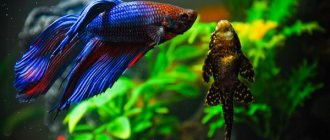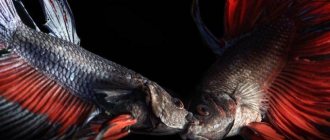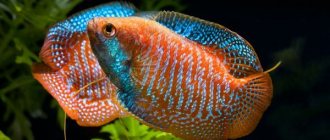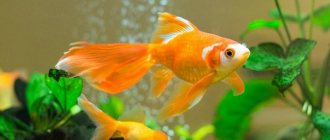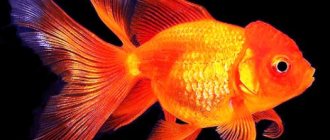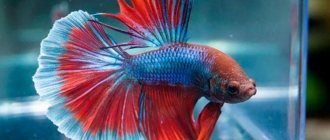Cockerel
Bettas are beautiful aquarium fish that have earned a bad reputation due to their personalities. Alas, these fish are pugnacious and do not tolerate either intraspecific proximity or with many other species. However, there are certain breeds that are loyal to such temperamental neighbors. Before combining several individuals of different species in one space, you must definitely find out the compatibility of the cockerels. Otherwise, conflicts can even lead to the death of its participants.
Cockfighting is a deadly competition.
Can I keep it with other fish?
Cockerels belong to the labyrinth fish that are able to breathe ordinary air with the help of a special organ. Species that are suitable for soft water and one-time feeding can live with cockerels.
When choosing neighbors for cockerels, it is important to consider the following points:
- Fish with long fins are not suitable for the neighborhood. The cockerels will attack them, mistaking them for rivals. Collisions can cause serious injury.
- Fish with a pugnacious character, like that of cockerels, are not suitable. Sooner or later, a fight will occur between them, which can lead to death.
- Cockerels do not tolerate cold water, so their neighbors must be comfortable with their favorable temperature conditions.
- You should not place fish that are too small or individuals that have not reached adulthood in an aquarium with bettas.
- Large or predatory fish will not like the cocky nature of bettas. They can be seriously injured in a confrontation with individuals that significantly exceed their weight. Up to and including death.
- It is recommended to house cockerels with other fish at a young age, before puberty. Then the fish will get used to its neighbors and will not be aggressive.
There should be at least 5 liters of water per rooster. If neighbors are added to the aquarium, then the volume has to be seriously increased. For a flock of 5 cockerels, experts say, you need an aquarium of at least 50 liters.
Diseases
Cockerels like to be petted, but this should be done rarely and carefully so as not to disturb the protective layer, otherwise infection will occur. Don’t be scared when the fish lies on its side on the bottom - it’s normal, if not for long. The onset of the disease is judged by the appetite and behavior of the cockerels, so pets should not be overfed and care of the aquarium should not be taken seriously.
Fin rot
The color of infected fish first fades, then the fins become covered with ulcers, rot and disintegrate, causing death. The disease is treated with streptocide and salt baths.
Oodiniosis velvet disease
The body of the cockerels is covered with a light yellow coating, the scales break and split. The color turns pale, the fish's fins droop, and it is difficult for it to breathe. Treat with antibacterial agents after disinfection and maintaining an elevated temperature in the aquarium.
Gill flukes
The causative agent is a fungus that grows to large sizes so that it hangs from under the gill covers. The disease is indicated by the appearance of mucus, a swollen body and discoloration, loss of appetite and difficulty breathing.
Ichthyophthiriasis semolina
The sick cockerel, the photo of which is presented above, is covered with small white dots, similar to semolina. Then he loses appetite and weight, becomes lethargic, breathes slowly, and swimming resembles twitching. Salt baths for 2-4 weeks will help cure the disease.
Dropsy
The abdomen is swollen and the eyes are swollen, the scales are raised, there are red spots on the stomach and near the fins, there is no appetite, lethargy. Treated with disinfection of equipment, Bicillin streptocide, weak manganese solution.
Columnaria
The cause of “mouth fungus” is bacteria. Symptoms: a swollen body close to the gills, which are covered with a dark coating, the mouth is affected, the eyes are filled with cloudy fluid. Treat with systemic complex antibiotics.
Costiosis
Appears as gray spots, the skin becomes cloudy, and there is copious mucus discharge. The disease is transmitted by the flagellate parasite. After starting treatment, recovery occurs within 7 days.
Bug-eye exophthalmia
The causative agent is a virus. The cockerel's eyes become enlarged, become cloudy and covered with a white coating. In advanced cases, the fish goes blind and dies. Sometimes it is enough to pour clean water and reduce the diet. In difficult cases, they are treated with ointments and antibiotics.
Good neighbors
Among all aquarium fish, there are several species that are more suitable than others for good neighborly relations with bettas. These are mostly small and non-aggressive fish.
Botsiya
The bots are often housed together with the cockerels, but the aquarium must be filled with shelters - grottoes, castles, caves, so that the less active bots can take a break from the more active and pestering cockerels. It is recommended to place from 3 to 8 bots in one aquarium so that they do not feel lonely among other species.
Mollies
Mollies get along well with pugnacious cockerels. These are quite large fish that do not have the habit of biting other people's fins. The main danger in this union is the mollies fry - active cockerels can simply eat them.
Gourami
Gourami are relatives of cockerels, so they have the same cantankerous character. These two species get along well with each other, but provided that the aquarium has a capacity of at least 80 liters. Otherwise, the fish will be cramped, and the games will develop into conflicts.
Neons
These luminous fish coexist quite peacefully with mobile cockerels. The only thing that can create problems is some discrepancy in temperature conditions. The ideal parameters for this pair are +24..+25 °C - this is the lower limit for cockerels and the upper limit for neons.
Catfish corridors
Corydoras are aquarium orderlies who get along well with various fish, including cockerels. Catfish are considered excellent cleaners, live on the bottom, and practically do not interfere with scurrying bullies.
Catfish have a calm and accommodating disposition, and their body length reaches 13 cm. Corydoras do not tolerate organic matter dissolved in water, so it must be periodically replaced, at least 50% of the total volume of water.
Ancistrus
These modest fish with dull colors easily get along with a wide variety of fish. The length of ancistrus is 10 cm. Like bettas, these fish do not tolerate salted water and are kept in fresh water aquariums. To ensure a calm environment in the aquarium, it is filled with plants and shelters.
Tetras
These fish are very similar to cockerels in character and behavior, but this in no way interferes with their peaceful coexistence. Tetras tend to travel in flocks, so bettas do not attack them for fear of receiving a massive response.
Rasbory
These fish are quite active and mobile. They practically do not pay attention to the scurrying cockerels, which are inferior to them in size. But bullies aren’t particularly interested in rasboras. For a more relaxed environment, the aquarium is filled with plants that will suit both types of fish.
Pecilia
These fish, like mollies, have a calm and peaceful disposition. They can easily live with bettas in the same tank if it is large enough and filled with vegetation. It is recommended to add red and orange colors to the aquarium to make it more vibrant.
Ternetia
Thorns coexist peacefully with the cockerels in the same aquarium. They are released in small flocks. This species is quite mobile and is not attacked by cockerels unless they have long thin fins, which the cockerels will certainly bite on.
Cardinals
Cockerels have no conflicts with small and inconspicuous cardinals. Bullies simply don't see the Cardinals as competitors and aren't interested in them. Due to their inconspicuousness, cardinals feel comfortable in the same aquarium with bettas, moving around at their own discretion.
Snails
You can add snails into an aquarium with bettas, but always adults. If the snails are small, the cockerels will simply eat them. The fish take them out of the shells and eat them with pleasure. The best neighbors for cockerels are helenas and ampullarias.
Description of the breed
The cockerel is a typical representative of the labyrinthine family. Their length is small, males reach 5 cm, females are slightly smaller - 4. Cockerels can be called the brightest aquarium fish. The color of the betta can be: yellow, orange, green and even blue. The colors shimmer and play in different shades. Males become brighter when fighting. During the breeding season, fish also paint themselves to attract a mate.
Female aquarium betta.
What are the distinctive features of females? It is easy to distinguish a female from a male: they are not so bright, their fins are short and not so luxurious, rather even modest. The female's body is slightly thicker and shorter. How many selection experiments have been carried out! Breeders managed to obtain the first specimens of females - bettas, which are definitely not inferior in beauty to males, but it is still almost impossible to get such a hybrid.
The fish have stripes across and along the entire body. The fins are rounded. The lower fin is very long from the chin to the tail. The fins on the chest have a sharper shape. If the fish is angry or excited, its gills swell and a collar forms around its head.
An interesting feature of cockerels is the ability to breathe atmospheric air. The so-called labyrinth organ perfectly helps fish cope with this function. It is for this reason that you need to ensure that the surface of the container is always clean and air can flow to the water.
Bettas are excellent jumpers. And that is why a special lid is often installed on top or a mesh is pulled up so that the poor jumper does not accidentally fly out of the container.
Our chickens prefer soft water. Do not use distillate under any circumstances: it contains not only harmful, but also beneficial substances . Aquarium stores sell special products to purify water from harmful substances, while leaving beneficial ones.
If you want to calm the fish, add a little salt to the water (1/2 tsp per 5 liters). Depending on the volume of the aquarium, the water in it needs to be changed 1-2 times a week, and in between, do this partially.
Cockerels love live food.
Bettas are fed both dry and live food. Bettas are predators and their main food is bloodworms, as well as earthworms. Tubifex, daphnia, and cyclops are also perfect. In order to protect the fish from overeating, you should remove the remaining food 15-20 minutes after feeding. Bettas need to be fed 1-2 times a day. It’s a good idea to set them up on a diet with one fasting day a week.
Fish are insensitive to temperature changes and therefore will be comfortable at both +18 and +26 degrees Celsius. Of course, you should not allow too cold or hot water. If you decide to add other fish to your betta, then you should take into account such a thing as aeration. The labyrinth fish can do without it, while its neighbors will most likely need it.
To keep the pond clean, do not forget to clean the bottom from food debris, waste products and other dirt, or have cleaners in the pond: catfish or snails. Both catfish and snails get along well with bettas.
Of course, the list of fish with which the betta gets along is very limited. So, it is best to add inconspicuous medium-sized fish to them. At first, you should keep an eye on your neighbors, because there is still a risk of a fight, and if the cockerels show aggression, then it is better to remove the neighbor. Although bettas respond well to gouramis, danios, angelfish and rainbowfish, they never mind chasing them. A cockerel fish may turn out to be a strange neighbor. Compatibility with other fish should always be checked in practice.
Relative compatibility
Along with favorable and unfavorable neighbors, there are fish that do not belong to any of these groups. They are considered to be of limited compatibility, since their cohabitation with cockerels carries certain risks, which increase if the conditions of detention are violated.
Angelfish
Majestic fish are quite capable of nipping cockerels by the fins. Their luxurious veils can be damaged by angelfish attacks. It is primarily adult fish that are dangerous. Young animals that grow up next to cockerels, as a rule, get along quite calmly with them.
Cichlazoma black-striped
This fish does not always get along with cockerels due to its pugnacious nature and habit of defending territory. They can get along with bettas, but only if the aquarium is very spacious and equipped with shelters.
Barbs
Most species of barbs have a cocky disposition. They are so active that they are constantly looking for victims to harass. Most often, barbs attack slow-swimming fish and those with long fins.
Bettas can also be attacked by barbs. To prevent damage from the actions of aggressors, bettas and barbs are kept only in large aquariums with plenty of cover and vegetation. There should be at least 6 barbs - this minimizes the risk of conflicts.
Minor
Minors are distinguished by their peacefulness and calmness. But they may have a desire to bite the fins of their neighbors. Minors can live together with cockerels, but in favorable conditions. It is necessary to monitor the behavior of the fish and, if necessary, remove the aggressors in time.
Lyalius
These are labyrinth fish, and they always coexist well with their relatives in the group. Bettas can sometimes attack lalius, so the aquarist must vigilantly monitor the behavior of the fish in the aquarium.
Reproduction and breeding
Aquarium bettas are ready to breed at 7-8 months of age. For crossing, a pair is selected that belongs to the same breed and is painted the same color.
Preparation stages:
- Keep partners separately for 1-2 weeks, providing them with a high-protein diet.
- Place them together in one 5-liter aquarium without soil, pour water no higher than 15 cm and place pots with plants. This will serve as a shelter for the female betta fish, and the male will need it to build a nest.
- To stimulate spawning, soften the water, throw in an almond leaf and raise the water temperature to 28-30 degrees. They don't give food.
- The future father builds a foam nest within 1-3 days.
- The female spawns eggs next to the nest. The male presses against her, helping to squeeze out 3-5 eggs, and immediately fertilizes, releasing milk.
- The eggs that fall out are picked up by the cockerel and placed in the nest. Then spawning is repeated.
When the spawning is over, the “husband” kicks out the girlfriend who needs to be removed. The rooster fish is a caring father: it independently nurses the future offspring, which appear in 1-2 days. To monitor the nest, he needs to leave a weak light on at night. When the young eggs emerge from the eggs and begin to swim on the second day, they will also have to be removed so as not to crush the fry.
Caring for fry
Caring for rapidly growing small bettas is not difficult, but requires maintaining cleanliness and a comfortable temperature. First, babies are sprinkled with crumbs from artemia or fresh ciliates and fed with washed egg yolk. Feed is given in the morning, at lunchtime and in the evening, in small portions, scattered over the surface of the water. After a week, they are fed with specialized baby pellets and finely chopped tubifex.
Lightly aerate and filter the water so that the surface is not covered with a bacterial film, and also to saturate it with oxygen until the fry develop a labyrinthine organ. Change 75% of old water every day. When the babies are 15-20 days old, they are sorted into small and large. At 1 month it is allowed to transplant into a larger container, but monitor the development of aggression.
Incompatible species
Some fish are strictly contraindicated in proximity to cockerels. They can be divided into three groups - the first can suffer from the aggression of cockerels, the second itself poses a danger to bullies, and the third are not suitable for the conditions of detention.
Guppy
These fish should not live with bettas, since as a result of their proximity, the fins and tails of smaller individuals may suffer. In addition, the small size of guppies provokes aggression in males.
Goldfish
These beautiful fish cannot live together with bettas due to different requirements for the temperature range of the water. In addition, the fish differ significantly in size, and the veiled fins of goldfish run the risk of being bitten by cocky bettas.
American cichlids
These are large aggressive fish that look at bettas and other small fish solely as prey. If you introduce bettas into an aquarium with American cichlids, the latter will be immediately eaten.
African cichlids
These are aggressive fish that tend to destroy any small fish. All neighbors who are inferior in size to territorial cichlids run the risk of becoming their victims. Cichlids will simply kill the bettas.
Tetraodons
These fish belong to the Four-Toothed family. They are very confrontational and do not get along well with their neighbors. Tetraodons will definitely tear off the fins of the cockerels. In addition, these fish love salted water, but it is contraindicated for bettas.
Cherry shrimp
Due to the small size of cherry shrimp, as well as other species, they often become prey for active and voracious bettas. Shrimp are especially often eaten after molting and at a young age.
Varieties
The betta is a species that is more correctly called a breed of one species of Betta, as well as others: Betta emerald and Betta imbellis are peaceful fish. Aquarium betta fish vary in the color of their scales and the shape of their fins. A separate group includes fighting fish, called royal or giant cockerels, as well as “Dragons”.
Veiled-tailed
The cockerel, the photo of which is presented, is the first selection work, the ancestor of other breeds of Siamese cockerels. The fins and veil tail are flowing and sway at the slightest movement of the fish.
Crown-tailed
The fins and veil-like tail of the cockerel are decorated with branched, jagged rays that form a crown around the cockerel. The fish come in three varieties:
- fins with single rays, in the form of a comb;
- the caudal rays are long, due to the membranes connecting them in pairs, similar to the tails of swallows;
- The paired elongated rays of the fish's tail intersect.
Delta Tail
The difference between a delta cockerel is a rigidly set tail with the formation of an angle of 130 degrees by the outer segments, which makes them look like a hang glider. If the angle is greater than this value, the betta is called a superdelta fish.
Two-tailed
The dorsal and pectoral fins of double-tailed bettas are veiled. The tail part of the fish consists of two halves.
Crescent
A popular breed of cockerel, which is distinguished by its fan-shaped tail in the form of an unfolded angle formed by the outer rays. Entering the body, the rays are located at an angle of 90 degrees. In another way, this breed of fish is called halfmoon.
Rosetail
The appearance of rosetail cockerels is similar to a superdelta. The tail of the fish is gathered in frills that do not straighten, and the ends are similar to pink petals.
Short-tailed
This breed of cockerels is more similar to its wild relatives in body shape and fins. The caudal fin is compared to an outstretched fan.
Poster
The fish are very aggressive. Wide fins of the breed (wider than long) on hard rays. The caudal fin of the cockerel looks like an open fan, the shape of the anal fin is elongated and pointed. In character and appearance, the poster cockerel is similar to wild representatives of the genus Betta.
Speartail
The fish's tail, with long central rays, resembles a pointed spear or a paint brush. Therefore, it is also called the brush-tailed cockerel.
Giant
During breeding, green betta fish were crossed to create a new breed. The length of the giant cockerel is 7.5-8 cm, the fins are short, brightly colored, which is why it is also called royal. The body of the fish with fins is purple, blue, green, red-blue or red-green.
The breed is divided:
- for short-tailed cockerels;
- half moontails;
- Veiled-tailed and crown-tailed giant cockerels are rare.
Dumbo or elephant-eared
These bettas are distinguished by their strong body and large white fins, like elephant ears, which are located next to the gills. These fish are also called fools and big-eared fish.
Photo gallery (21 pieces)
SONY DSCIs it possible to keep two bettas in one aquarium?
Cockerels are aggressive, so it is not recommended to keep them in groups. Especially conflicting males. They are cocky and constantly fight for territory, injuring each other. A fatal outcome is excluded, but the fins will be seriously damaged.
Females are not so aggressive, and can live 4-5 individuals in an aquarium. If one of the fish shows increased aggression, you have to move the individual to a separate aquarium. The best option is one male and several females. Then the likelihood of conflicts will be minimized.
Guppy
The most popular of the popular aquarium fish. Peace-loving and unpretentious - a true decoration of any aquadome. Male guppies are smaller, but much brighter and more beautiful than females. Under the wrong conditions (for example, too many neighbors), it can show aggression towards its fellow tribesmen.
Conditions of detention:
- Aquarium volume from 20 liters;
- Aeration and filtration are desirable, but not necessary;
- A water temperature of around 20 degrees for guppies is considered optimal;
What to look for?
The situation in the aquarium largely depends on the conditions of detention. The better they are, the greater the chances for peaceful coexistence of the inhabitants of the aquarium.
Aquarium volume
A tank holding 10 liters of water is enough for one rooster. For several fish you need larger containers. The more spacious the aquarium, the more comfortable and peaceful the existence of the bettas will be.
Decorations and shelters
Active and temperamental fish like bettas definitely need places to hide. Females often get tired of the male’s advances, so they hide in grottoes and caves, among dense vegetation.
The presence of various types of shelters allows you to defuse the situation in any aquarium. If one of the fish wants to retire and take a break from overly active neighbors, they can hide in shelters prepared for them.
Controlling cockerel behavior
If bettas are kept in an aquarium with other fish, the aquarist should carefully observe their behavior. It is important to control the relationship between cockerels and neighbors. If conflicts are brewing and the fins are under attack, it is necessary to remove the aggressor.
Features of living alone
If there is a conflictual atmosphere in the aquarium, do not panic. The problem will be solved by placing aggressive fish in a separate aquarium. Cockerels easily tolerate loneliness, and practically do not worry about the lack of companions.
Cockerels, despite their quarrelsome and conflicting disposition, with proper organization of life in the aquarium and with the right choice of neighbors, can lead a completely peaceful life. Their complex character is more than compensated for by their special fishy “charisma” and excellent external data.
